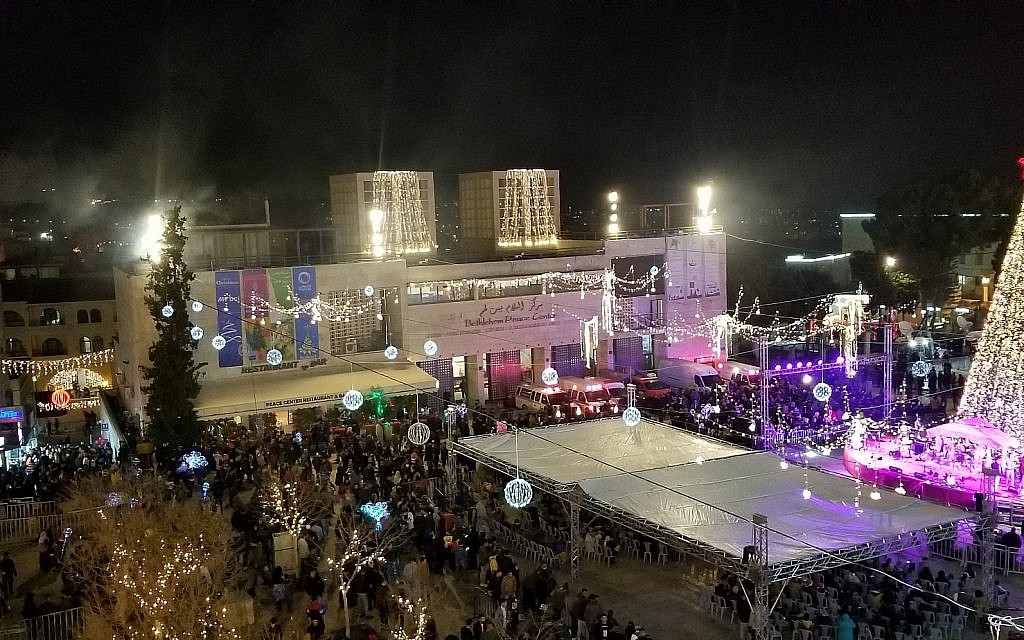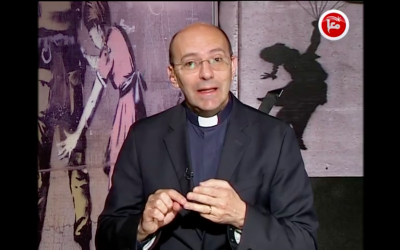Community makes up less than 1% of West Bank and Gaza population, according to PA; in past 50 years, thousands have emigrated, Lutheran pastor says

BETHLEHEM, West Bank — Thousands of Palestinians and international visitors descended on Bethlehem on Monday night to celebrate Christmas in the city feted as the birthplace of Jesus.
Cars were lined up in traffic jams in and around the historic pilgrimage site and Star Street, the main thoroughfare in Bethlehem’s old city, was packed with revelers who had come for the Christmas Eve festivities.
A tall and brightly lit Christmas tree stood in the middle of Manger Square, the plaza adjacent to the church claimed to be built on the site where Jesus was born, and groups of Palestinian locals sang holiday carols and other songs atop a stage adorned with glowing baubles.
Palestinian political and security officials and church leaders, meanwhile, arrived in motorcades and entered the Church of Nativity ahead of midnight mass.
Islam Afghani, a 27-year-old Muslim construction worker from Nablus, said he came to Bethlehem to demonstrate his support for Palestinian Christians.
“We are all one people. There is no difference between us,” Afghani said, referring to Christian and Muslim Palestinians. “I consider their holidays to be my holidays and they consider my holidays to be their holidays. I came to express solidarity with them.”
According to Palestinian Authority Tourism Minister Rula Maaya, all Bethlehem hotels were fully booked, and the city was preparing to host an “astounding” 10,000 tourists overnight.
“We haven’t seen numbers like this in years,” she said, adding that the 3 million visitors to Bethlehem in 2018 exceeded last year’s count by hundreds of thousands.
But while Christian tourism from abroad may be booming, the West Bank’s local coreligionists have seen their numbers dwindling in recent years.
Palestinian Christians currently make up just under 1% of the overall Palestinian population in the West Bank and the Gaza Strip, according to the Palestinian Authority Bureau of Central Statistics. There are 46,850 Palestinian Christians living in the West Bank and 1,138 residing in the Gaza Strip.
Palestinian Christians have been emigrating from what is today Israel, the West Bank and the Gaza Strip since the first half of the 20th century, Mitri Raheb, a Lutheran pastor and the president of Dar al-Kalima University College of Art and Culture in Bethlehem, told The Times of Israel from the rooftop of the Bethlehem Municipality building.

The largest wave of Palestinian Christian emigration, however, took place during the Israeli War of Independence, Raheb said. The Palestinian Christian population between the Jordan River and the Mediterranean Sea went from 8% to 2.3% in the course of the conflict, he noted.
In the past 50 years, tens of thousands of Palestinian Christians have emigrated from the West Bank and Gaza, he added.
Lana Vivian, a 27-year-old Christian nurse from Bethlehem, said many members of her family have left and now live abroad.
“I plan to stay here, but about 50% of my family has left for Australia, America and other places,” she said.
Hundreds of thousand of Palestinian Christians live in Latin America in countries such as Chile and Honduras.
Rehab, along with other scholars, authored a book about Palestinian Christian emigration, which was published in 2017. He said a survey they conducted for the book found that 28% of Palestinian Christians would like to emigrate.
Rehab also said the poll, which surveyed some 500 Palestinian Christians, found most of the Palestinians who want to leave would like to do so to improve their economic status and escape Israel’s military rule. He said well less than ten percent of Christian Palestinians said they want to emigrate because of religious persecution.
Many Israeli officials have long argued that the steep decline in the Palestinian Christian population in the West Bank and Gaza relates to Palestinian Muslims persecuting them.
“Bethlehem had when we handed it over to the Palestinian Authority a Christian population of roughly 80%. Now it’s about 20%,” Prime Minister Benjamin Netanyahu told reporters in October. “That change happened because in the Palestinian Authority areas, as well as throughout the Middle East, Christians are being constricted, they’re being pressured, also they’re being persecuted.”
MK Michael Oren, a former Israeli Ambassador to the US, echoed Netanyahu’s remarks in an interview with CBS in 2012, arguing he believes Christian Palestinians have been leaving the West Bank because of “duress” imposed on them by their Muslim neighbors.

In the past several decades, there have been some acts of violence against Palestinian Christians in the West Bank and Gaza. For example, two churches in Nablus were firebombed in 2006 after Pope Benedict XVI cited a text an obscure medieval text that characterizes some of the teachings of Islam’s founder as “evil and inhuman.”
Khalil Shokeh, a former Bethlehem city council member who has significantly researched Palestinian Christians, said he believed incidents like the fire-bombings in 2006 are “rare” and “individual acts.”
“They don’t reflect don’t reflect a movement in any way,” he said.
Back at Manger Square, the crowd started to swell as the later hours of the evening started to arrive.
The Coordinator of Government Activities in the Territories, the branch of the Defense Ministry responsible for liaising with the Palestinians, said it provided some 500 permits to Palestinian Christians from Gaza to visit the West Bank and Jerusalem. It also said it granted 100 permits for Palestinian Christians to travel abroad via the Allenby border crossing between the West Bank and Jordan.
A spokeswoman for Gisha, an Israeli human rights groups, said Israeli authorities sent church officials a list of 104 Christian Palestinians from Gaza with “security blocks.”
Palestinians with “security blocks” include persons who an Israeli government authority has flagged as a security concern, according to defense officials.
As reported by The Times of Israel
